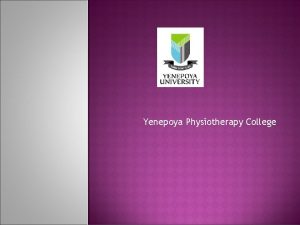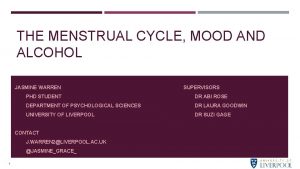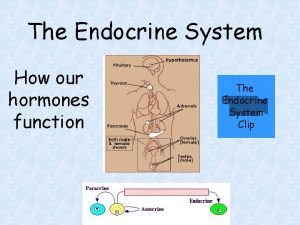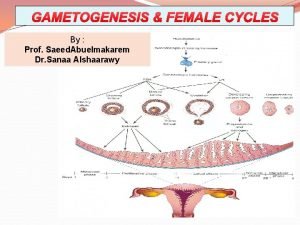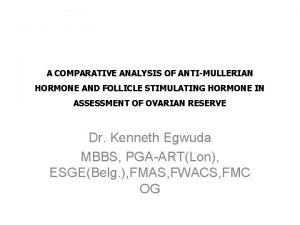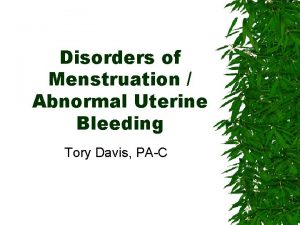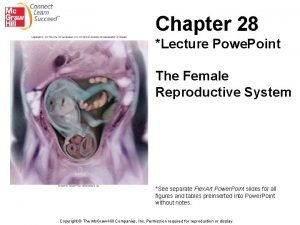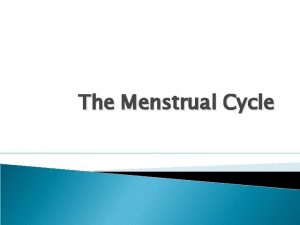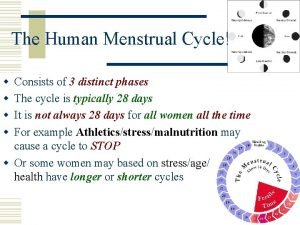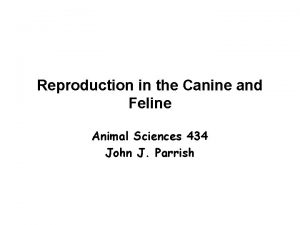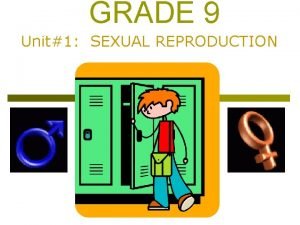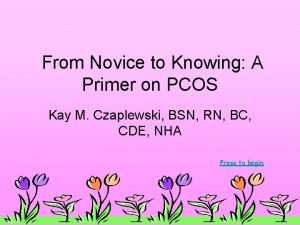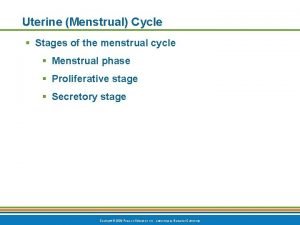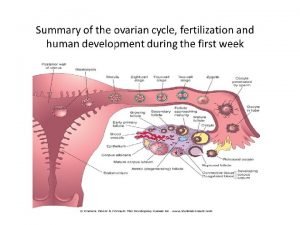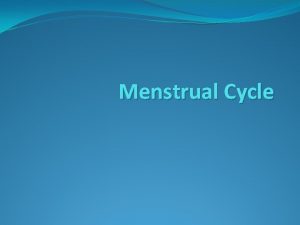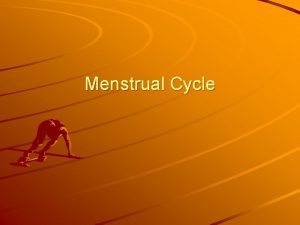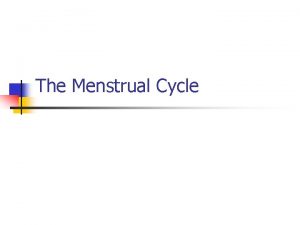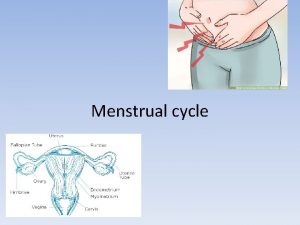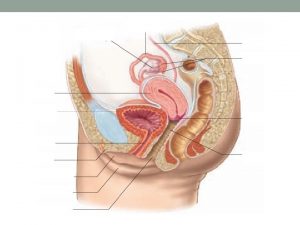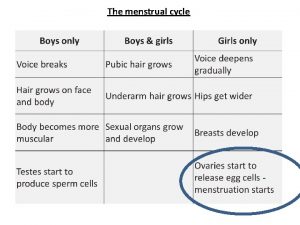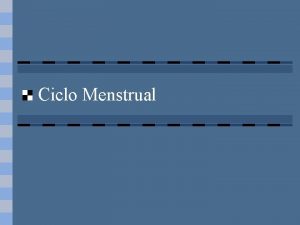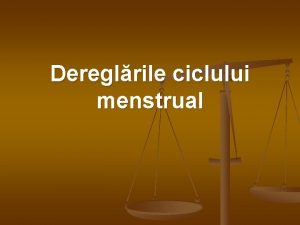Menstrual cycle Ms Navya Lecturer Yenepoya College of




























- Slides: 28


Menstrual cycle • Ms. Navya • Lecturer • Yenepoya College of Nursing • Date : 13/02/2019 • • Peer reviewed by: Mr. Anand Assistant. Professor Community Health Nursing

Menstrual cycle • OBJECTIVE • Student will be able to • Describe what is menstruation and about menstrual hygiene practices.

Importance • Globally, approximately 52% of the female population (26% of the total population) is of reproductive age • women and girls will menstruate each month for between two and seven days

Cont…. • In most parts of the world, it remains taboo and is rarely talked about • Currently, cultural practices and taboos around menstruation impact negatively on the lives of women and girls, and reinforce gender inequities and exclusion

DEFINATION • Discharge of bloody fluid containing endometrial cells, glandular secretion, and blood cells, lasts 3 -5 days

What is menstruation • Girls typically start to menstruate (‘the time of menarche’) during puberty or adolescence. • At this time, they experience physical changes (eg growing breasts, wider hips and body hair)emotional changes due to hormones.

Cont. . • Menstruation continues until they reach menopause, when menstruation ends, usually between their late forties and mid fifties • Menstruation is also sometimes known as ‘menses’ or described as a ‘menstrual period

Basic terms • • Endometrium: Lining of the uterus Oocyte: Developing reproductive cell Ovum: Mature egg after meiosis Menopause: Last menstrual cycle, after which egg production stops

Phases of the menstrual cycle • • menstruation the follicular phase ovulation the luteal phase.

Menstruation • Menstruation is the elimination of the thickened lining of the uterus (endometrium) from the body through the vagina. • Menstrual fluid contains blood, cells from the lining of the uterus (endometrial cells) and mucus. • The average length of a period is between three days and one week.

Follicular phase • The follicular phase starts on the first day of menstruation and ends with ovulation. • Prompted by the hypothalamus, the pituitary gland releases follicle stimulating hormone (FSH). • This hormone stimulates the ovary to produce around five to 20 follicles, which bead on the surface. • Each follicle houses an immature egg.

Cont. . • Usually, only one follicle will mature into an egg, while the others die. • This can occur around day 10 of a 28 -day cycle. The growth of the follicles stimulates the lining of the uterus to thicken in preparation for possible pregnancy

Ovulation • Ovulation is the release of a mature egg from the surface of the ovary. • This usually occurs mid-cycle, around two weeks or so before menstruation starts. • During the follicular phase, the developing follicle causes a rise in the level of oestrogen.

Cont… • Within two days, ovulation is triggered by the high levels of LH. • The egg is funnelled into the fallopian tube and toward the uterus by waves of small, hairlike projections. • The life span of the typical egg is only around 24 hours. Unless it meets a sperm during this time, it will die

Luteal phase • During ovulation, the egg bursts from its follicle, but the ruptured follicle stays on the surface of the ovary. • For the next two weeks or so, the follicle transforms into a structure known as the corpus luteum. • If pregnancy does not occur, the corpus luteum withers and dies, usually around day 22 in a 28 -day cycle.

Cont. . • Using highly absorbent tampons during a menstruation causes toxic Syndrome. • Use of tampons when not menstruating Can lead to vaginal irritation and delay the seeking of medical advice (eg to absorb vaginal secretions) for the cause of unusual vaginal discharge 30.

Cont. . • Wiping from back to front following Makes the introduction of bacteria from the bowel into the vagina urination or defecation (or urethra) more likely. • Unprotected sex Possible increased risk of sexually transmitted infections (see below) or the transmission of HIV or Hepatitis B during menstruation.

Cont. . • Unsafe disposal of used sanitary materials Risk of infecting others, especially with Hepatitis B. • Lack of hand-washing after changing a Can lead to the spread of infections such as Hepatitis B or Thrush.

Menstrual hygiene • If you are re-using a cloth, put it into a plastic bag until you can wash it with hot water and soap and then dry it in the sunshine or iron it. • If you are using a pad, tissue or cotton, or want to dispose of

Menstrual hygiene • If there is no other option, drop it straight in the latrine pit as long as it is not a water seal pour flush pan as this could easily become blocked

• Every day (morning and evening if possible) wash your genitals with soap and water. • Take bath daily • Change the cloth daily

How to manage the stomach pain from your period • You can put a bottle with hot water on your stomach area when you are resting. • Try to do some exercises and keep your body active. • You can take painkiller medicines every four to six hours on the most painful days.

To manage menstruation hygienically, • it is essential that women and girls have access to water and sanitation. • They need somewhere private to change sanitary cloths or pads; • clean water for washing their hands and used cloths; • And facilities for safely disposing of used materials or a place to dry them if reusable. • There is also a need for both men and women to have a greater awareness of menstrual hygiene

Conclusion • The consequence is that women and girls mostly have use moisture and damp cloths. There is, however, a big demand for affordable sanitary napkins. To fulfil this need sanitary napkins are produced locally at a reasonable price on the initiative of the Bangladesh Rural Advancement Committee.

Recapitulation • Define menstrual cycle • List down the phases of menstrual cycle • Explain the importance of menstrual hygiene

Reference • • K. Park Community Health Nursing Neelam Kumari Community Health Nursing N. J Singh Community Health Nursing Thressiamma Community Health Nursing.

• Thank you
 Lecturer's name or lecturer name
Lecturer's name or lecturer name Electroplating station
Electroplating station Nephritis
Nephritis Yenepoya physiotherapy college
Yenepoya physiotherapy college Ovulation negative feedback
Ovulation negative feedback Conclusion for menstrual cycle
Conclusion for menstrual cycle Types of hormones in human body
Types of hormones in human body Prof baud
Prof baud Stage of menstrual cycle
Stage of menstrual cycle Conclusion for menstrual cycle
Conclusion for menstrual cycle Menstrual cycle terminology
Menstrual cycle terminology Powe point
Powe point Menstrual cycle stages
Menstrual cycle stages Menstrual cycle
Menstrual cycle The human menstrual cycle
The human menstrual cycle How long is a dog in heat
How long is a dog in heat Menstrual cycle defination
Menstrual cycle defination Menstrual cycle safe days chart
Menstrual cycle safe days chart Endometrial histology menstrual cycle
Endometrial histology menstrual cycle Ilias yengage
Ilias yengage Jeannie watkins
Jeannie watkins Spe distinguished lecturer
Spe distinguished lecturer Good morning message to my lecturer
Good morning message to my lecturer Photography lecturer
Photography lecturer Lecturer in charge
Lecturer in charge Designation lecturer
Designation lecturer Designation of lecturer
Designation of lecturer Gcwak
Gcwak Lecturer name
Lecturer name



